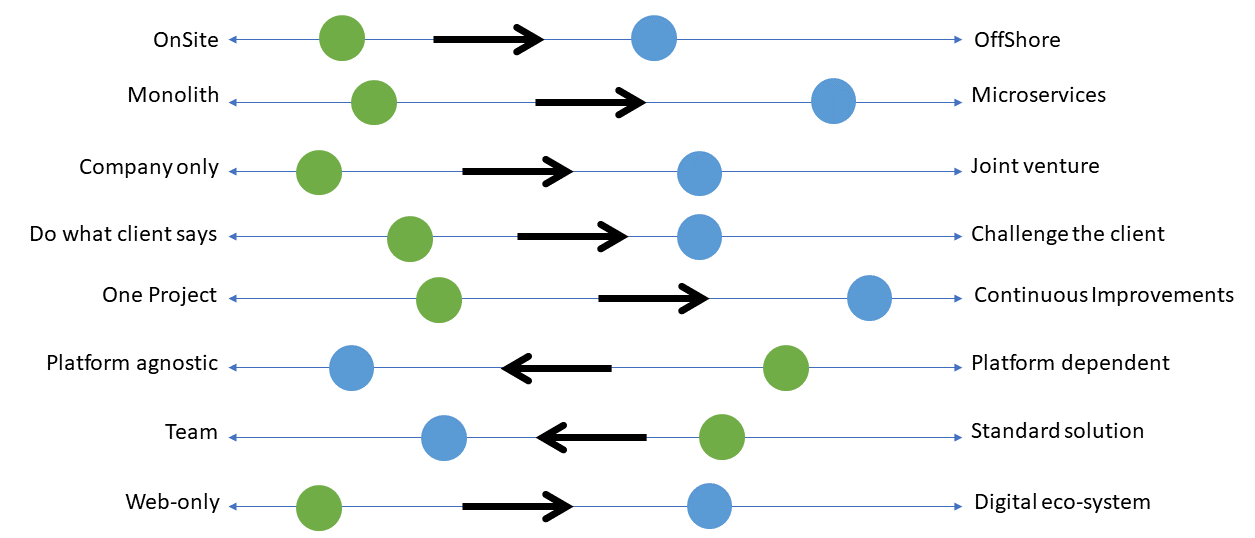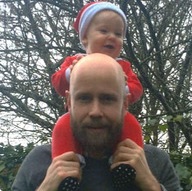TechLeads
A little more than a year ago, while I was in the middle of the CDC project I was approached by the holding CEO. He had recently started an initiative where the branch office CTOs where to meet and investigate if they could find some common ground cross-border. The holding CEO thought it was a good idea for me to join the group since I was in the middle of building the Nordic infrastructure for the company. I agreed.
Oslo
There had been some talks and a couple of Skype meetings between the CTOs before I joined the group, but not any major decisions had been reached. The first physical group meeting was to be hosted by the group CEO himself, on his home turf back in Oslo. The group members arrived in the morning, and was stewarded into the war-room, where we were gonna spend the remainder of the day, hammering up some common strategies. The CEO had made an agenda, complete with team building exercises. Luckily, I had met most (all?) of the participants already, so it was not very awkward for me. It may have been for some of the others though. On the agenda was
- Increase visibility. Suggest three hype subjects for the company to make its own.
- Flexible resources. Basically, have more developers off-shore and in the form of freelancers. I have written more about it here.
- Partners and technologies. Identify which partners and what technologies to (not) work with.
- CIIPs (Company Integrated Intellectual Property). Identify re-usable packagings to put on offer. This is harder then it sounds, since the company do tailor made solutions for customers in all type of industries, so creating some sort of one-size-fits-all package is difficult.
We divided ourselves in smaller groups to work on these topics. I and the Danish CTO were paired, and our topic was to dive into Increase visibility aka Hype subjects. We (me and the Danish CTO) concluded not to regurgitate a lot of tech buzzwords, but instead try to envision a process for handling new technology within the company. I’m sure the Holding CEO was disappointed by the lack of buzzwords. Anyways, we decided that the company need to ask itself these questions when approaching a new technology:
- Will it motivate employees?
- Is it relevant in the market?
- Will it grow business?
We decided to describe the stages when a technology is incorporated in the company like this:
- Digital Business Ecosystems (Technology in production)
- Emerging Technologies (Hype Cycle Technologies)
- Technology intelligence (Monitoring and evaluating technologies in use)
And the actions on our topic was to:
- Define one hype topic within each stage together with the rest of the tech organization
- Construct a task force that will increase visibility on each of the topics selected.
Big plans! Big words! As for the other groups I’ll just briefly mention their conclusions:
- The flexible sourcing gang talked mainly about maintaining a culture where it’s easy to have freelancers and remote teams.
- The partners and technologies crew talked mainly about how and why to partner up with a vendor. No particular technologies nor potential partnerships were mentioned.
- The CIIP posse talked mainly about tooling and process when using a CIIP, for example stuff like NuGet packages, internal Stack Overflow and what not. No actual examples of CIIPs were mentioned, much to the CEOs disappointment I can imagine.
All in all, I think it was a good session. We covered a lot of ground and got to know each other. We didn’t suggest one single thing the top-level management wanted to hear though, and to be honest, nothing we had concluded was really actionable. We decided to schedule a meetup in Stockholm a couple of months later.
Stockholm
I hosted the Stockholm session, since it’s my home turf, and gathered all of the group members in our flagship conference room. The Finnish branch CEO had joined the gathering, I guess to make sure we’d focuse our efforts and produce actionable results and/or reach some decisions. I considered him the nanny. The theme for the meet-up was alignment. At the time I kind of thought it to be a waste of time, but in hindsight I’ve come to realize it was necessary. The alignment manifested itself in us, the group, doing a slider exercise where we were to, individually, mark our selves on a white board, plotting out where we considered ourselves on the scale as of now, and how we wanted to be positioned in the future. We first spent an hour or so deciding on what opposites to use on the scales, and this is the end result.

The green dots represent the average on where we considered ourselves today, and the blue dots represent the average of where we want to be in the future. On average, as a group. On some of the rulers our individual dots were very dispersed and on others they were very collected. However, we all had the same direction, we all wanted to move similarly, which really became an eye-opener for us, and boosted us with energy to actually take some decisions and put down some actions. But time had ran out for this meeting, and the only action I can remember, was to assign one of us (the Swedish CTO drew the shortest straw) to send to Oslo the upcoming week to present on the Groups work so far in front of NMT, Nordic Management Team, the highest governing body within the organization. Of course, the Norway tech leads was gonna join the presentation, but since the Norway branch had no CTO at the time, we felt someone from another branch needed to be onsite to speak for the group. Yes, another action decided was to conduct the slider exercise with all the developers in all branch offices. That way we would be able to see if the Tech Leads stance aligned with those of the general tech population in the company! To, me this was brilliant, and even though we’d seen little action yet, I finally saw a bright future for the cooperation of the group!
Aarhus
Three months later I found myself in Aarhus, sharing a cab with the Norwegians who had landed at the same time. With us was the new CTO in the Norway branch and the 40-minute ride from the small airport to the office was spent catching up.
The Danish branch CTO had prepared an agenda, and this time focus was bragging about presenting some successful customer cases. The hot topic was micro services and one Danish and one Swedish solution was flaunted. We also got to try out a VR solution the Danes had built for a client.
We spent some time with our cross-border alignment. All branches had conducted the slider exercise with the local developers, and as we suspected, the results aligned very well with those of the TechLeads group.
We also spent some time discussing our relationship witch our primary tech partner. To me it was a real eye-opener when the Swedish CTO (who possesses the closest ties with the partner) painted a picture of a not-so-bright future for our partnership. I don’t think the others felt the same sense of urgency as me, I think the Norwegian CTO even waved it away, but at least I had joined the Swedish CTO in believing the company needed to act, and act fast, to rid ourselves of the dependency of the tech partner in question.
I can’t recall any actions, except for agreeing that the Swedish CTO, based in Gothenburg, should give a presentation on behalf of the group in front of the NSM (Nordic Sales and Marketing) team, regarding our agreed upon tech positioning and strategy, focusing on our desire to move in the micro services direction (and therefore relieving us from being so heavily dependent on one single partnership).
Gothenburg
When I arrived at the Gothenburg office, a warm, late august morning, I was surprised to discover I was the first of the group on-site, even though I had just taken the 3,5 hours trip from Stockholm. But soon after, the Gothenburg CTO showed up, and the rest of the group appeared shortly after. With us was a new member of the group, the new Stockholm CTO, and it was also the first time we met. We gathered in a conference room and set about the agenda. Even though we spent quite some time on getting the new member up to speed and describing the latest Swedish reorg to the others, we managed to cover some ground on the agenda. We were presented with some success cases from the Finnish branch, we got a recap of the NSM presentation (they had not understood much of what we wanted to communicate in regard to positioning and strategy), we debated some more regarding the risk of being in the lap of our partner, and we decided on some actions to strengthen collaboration cross-border. I was assigned with executing on two of those actions: setting up a common GitHub in order to gradually demote all local repos (Github/TFS/Bitbucket), and also making sure all developers was invited into the common slack workplace (we currently have one slack instance in each country). My colleague Micke had set up the common Github within a day from the meeting and I had invited all developers to the common slack workplace already on the train back to Stockholm. I have not yet seen any progress on the other actions that was handed out though. Yes, we also decided the next meeting should take place in Helsinki in a couple of months.
Conclusion
Well, the group has existed for a year now. I, overseeing IT, the only truly cross-border entity in the company, am trying to keep momentum in the group. Since I travel to all offices on a regular bases, I try to pass messages and get face-to-face with the group members in order to keep things moving. But it’s difficult. The ideas are good. The process is fine. The alignment is there. But it just takes too long for actions to happen. On the latest gathering we discussed this, and everyone agreed it’s difficult to keep momentum since the groups work is on top of pre-existing, local assignments. I also see a problem with the lack of a leader for the group. And no one is really inclined to pick up the bill for our collaboration, and that makes us even less motivated to meet. But I have seen some good things come out of this collaboration. We have some customer cases that has actually been cross-border efforts. Because of the TechLeads group, people have reached out to each other, and that would have never happened if they had not met. We have reached an understanding for each other’s challenges and possibilities. We have a strategy. And I personally have learned a lot. I just wish we’d be able to pick up the pace a little and start executing on the strategy!
The personal experiences, viewpoints and opinions expressed in this blog post are my own and in no way represent those of the company.
